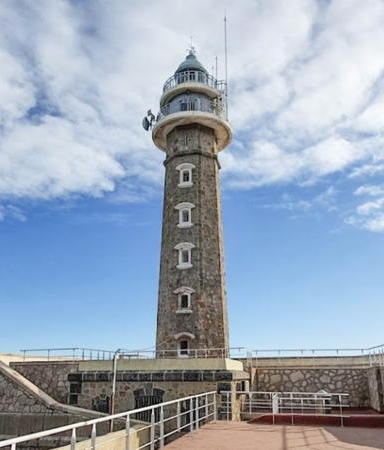The Kingdom of Spain occupies nearly 85% of the Iberian Peninsula in southeastern Europe with coastlines facing south and southeast on the Mediterranean Sea and northwest on the Atlantic Ocean. Spain also includes the Balearic Islands in the Mediterranean, the Canary Islands in the Atlantic, and the cities of Ceuta and Melilla on the north coast of Morocco.
Since 1978 Spain has been divided into 17 regions called autonomous communities (comunidads autónoma) that have been granted varying degrees of autonomy by the central government. The autonomous communities are subdivided into provinces (provincias). This page includes lighthouses of three provinces in eastern Spain: Castellón, Valencia, and Alicante. These three provinces form an autonomous community called the Valencian Community (Comunidad Valenciana). Its coastline faces southeast on the Mediterranean, bordering Murcia to the south and Catalonia to the north.
The word for a lighthouse is faro in Spanish but its use is generally restricted to the larger coastal light stations. Smaller lighthouses are called balizas (beacons). In Spanish isla is an island, cabo is a cape, punta is a promontory or point of land, péñon is a rock, arrecife is a reef, bahía is a bay, ría is an estuary or inlet, estrecho is a strait, río is a river, and puerto is a port or harbor. In the Valencian Community many people speak Valencian, a language closely related to Catalan. In Catalan the word for a lighthouse is far, balisa is a beacon, illa is an island, cap is a cape, punt is a promontory or point of land, roca is a rock, escull is a reef, badia is a bay, ria is an estuary or inlet, estret is a strait, riu is a river, and port is a port or harbor.
The navigational lights in Spain are the responsibility of the national port authority, Puertos del Estado, but many of them are operated and maintained by regional port authorities. The Comisión de Faros, founded in 1842 to build and maintain Spanish lighthouses, is now an advisory panel.
ARLHS numbers are from the ARLHS World List of Lights. ES numbers are from the Spanish national list of lights, Libro de Faros. Admiralty numbers are from volume E of the Admiralty List of Lights & Fog Signals. U.S. NGA List numbers are from Publication 113.
- General Sources
- Libro de Faros y Señales de Niebla
- Online edition of the official Spanish light list.
- Online List of Lights - Spain - Balearic Sea and Southeast Coast
- Photos by various photographers posted by Alexander Trabas. Many of the photos for this coast are by Eckhard Meyer.
- Phares d'Europe
- Photos posted by Alain Guyomard and Robert Carceller.
- Lighthouses, Islands and Capes
- This collection of photos by José Miralles Pol has some fine photos of lighthouses in this area.
- Spain Lighthouses
- Fine aerial photos posted by Marinas.com.
- Lighthouses in Spain
- Photos by various photographers available from Wikimedia.
- World of Lighthouses - Spain
- Photos by various photographers available from Lightphotos.net.
- Spanische Leuchttürme auf historischen Postkarten
- Historic postcard images posted by Klaus Huelse.
- GPSNauticalCharts
- Navigational chart information for Spain's Mediterranean coast.

Cabo de la Nao Light, Marina Alta, May 2023
Google Maps photo
by Provincia Teruel









